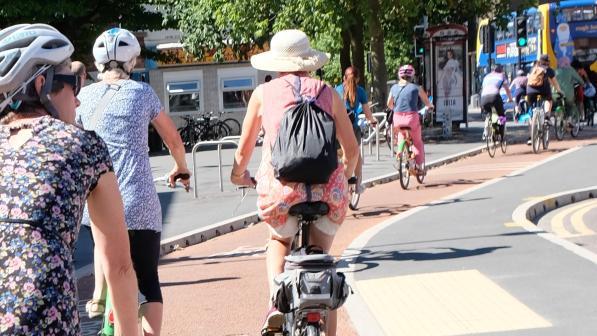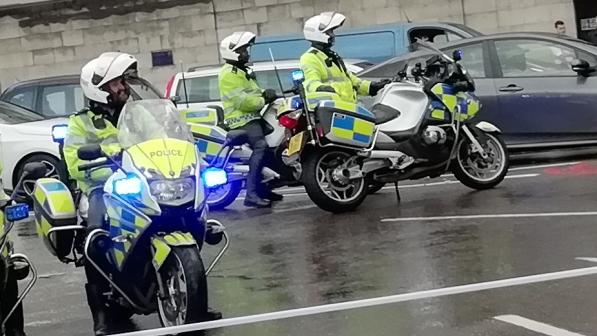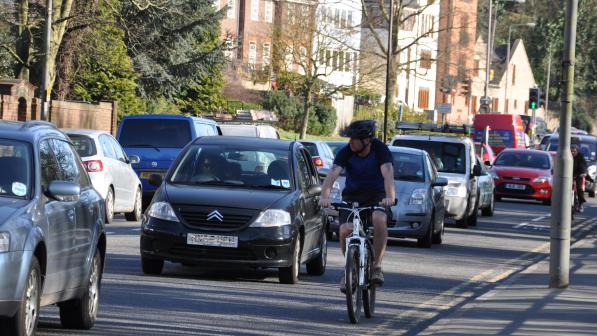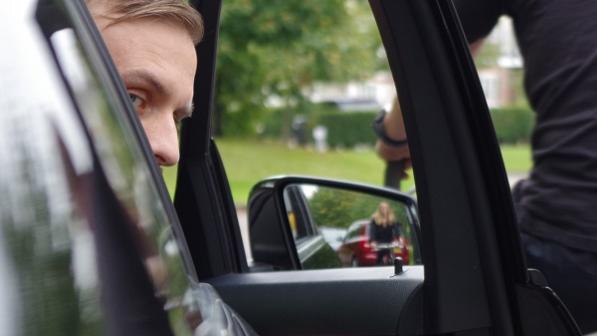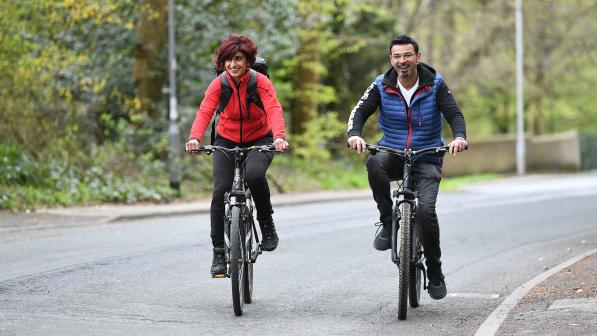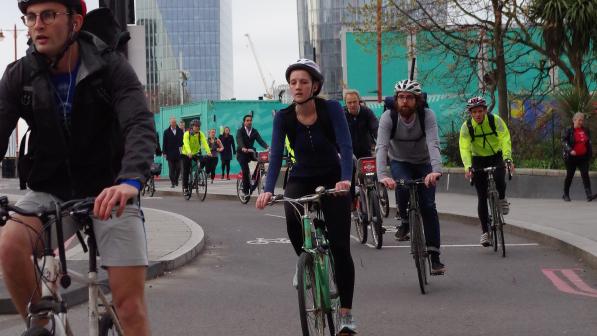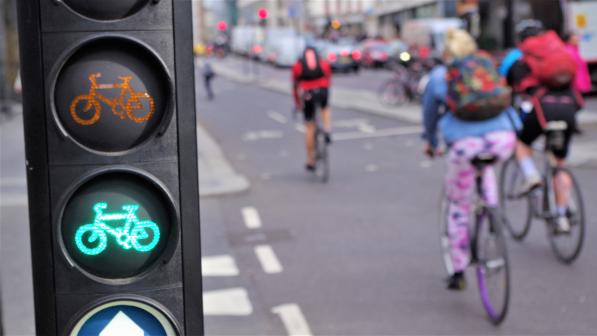Why do cyclists need priority at junctions - and how should it be done?

Update: 28 July 2020
Since this article first appeared, Cycling UK has been closely involved with the Department for Transport's (DfT) pre-consultation on a review of the Highway Code.
The DfT has now announced an official consultation and we're pleased to say that many of the new rules we've suggested are among the proposals. One of them is to introduce a 'Hierarchy of Users' or ‘Hierarchy of Responsibility’, recognising that road users who pose greater risks to others ought to have a higher level of responsibility; and another is to simplify the rules relating to non-signalised junctions, which will make junctions safer and address ‘left-hook’ collisions.
But, to make these proposals a reality, it's vital that road users of all kinds write to the DfT to show their support. Otherwise, they could be dropped. Please help us make it happen! (Deadline 27 October 2020).
Support changes to make the Highway Code safer
Thank you.
Please read on for our original article.
Cycling UK's key recommendations
Cycling UK wants the Government to:
- Resolve the conflicts in transport policy, guidance and practice that currently undermine the ubiquitous implementation of the ‘hierarchy of users’ and, in doing so, compromise safe road conditions for pedestrians and cyclists;
- Implement the suggestions set out in the research report, ‘Turning the Corner’, to further simplify pedestrian and cycle crossings - both signalled and non-signalled - thereby providing better, continuous walking and cycling networks in local areas;
- Enforce clear, unambiguous priority for pedestrians and cyclists over turning traffic through alterations both to the Highway Code and legislation.
Junction priority and the 'hierarchy of users'
Guidance endorsed by the Government (e.g. Manual for Streets 1 & 2 and other documents) nominally respects a ‘hierarchy of users’, which gives priority to people with disabilities, cyclists and pedestrians.
In reality, however, the design (both geometric and aesthetic) of most roads reverses this hierarchy, with most footways (and nearly all cycleways) designed with the clear expectation that their users yield to motor traffic.
This is exacerbated by the expectation, created by the Highway Code and accompanying legislation, that all modes have an equal responsibility to ‘look out’ for each other in all circumstances. Yet such an equivalence cannot rationally exist given that pedestrians and cyclists are both far more vulnerable, and their ability to cause harm to others is negligible, when compared to people inside vehicles.
This means that, though the hierarchy is repeatedly exhorted in design documents, there is little backing for it in legal frameworks. This has proven particularly problematic to designers seeking to introduce ‘shared space’ (or, to use newer, less controversial / confusing terminology, ‘informal’ or ‘enhanced’ streets). Also, designers find that blind and visually impaired people are often concerned that the system of ‘negotiated priority’ (i.e. rather than ‘legal’ priority) makes navigating some layouts and junctions both confusing and challenging.
To address this, Cycling UK believes that:
- National and local planning policy must ensure that the layout of most urban streets prioritises foot or cycle traffic. In practice, this means adopting continuous footways and cycleways as standard designs on all distributor routes, with ‘filtered permeability’ to guarantee advantages to those on foot or bikes (i.e. allowing through access for walking and cycling, but removing it for motor traffic).
- Stronger, clearer legal support for the hierarchy of users needs to be implemented to give planners, designers, engineers and road safety auditors the confidence to agree to schemes that are bolder in giving priority to cycling. This could be achieved, for instance, by clear, unambiguous statements in the Highway Code (see below), as well as alterations to legislation as set out in British Cycling’s ‘Turning the Corner’ report.
Turning the Corner: making junctions better
Cycling UK wholly supports the recommendations outlined in a report produced by Phil Jones Associates for British Cycling, ‘Turning the Corner’.
This sets out various problems with current practice, deficiencies in the law and ways in which Highway Code rules can be improved to ensure stronger protection for parallel cycle facilities and footways (see below). It outlines recommended improvements for two junction types:
- Side-road entries and exits
- Larger signalled junctions
Improving cycle and pedestrian priority at side-roads: design options
The problems
A few design options exist for giving cyclists priority over side-roads, but none is ideal. For example, if there is enough space, a cycle track can be ‘bent out’ so that the point where it crosses a side road is slightly set back from the main road - but this is not usually possible on urban roads, due to the presence of buildings.
Alternatively, a new design for zebra crossings which permits cycling parallel to pedestrians can be used - but this requires substantial roadside furniture and road markings, and is seldom used close to the mouths of side-roads.
Nevertheless, many authorities (e.g. Transport for London, Brighton and Nottingham City) are coming up with design solutions - but there is no consistency amongst them.
Also, legal protection for people on parallel cycle lanes or cycle paths over traffic turning across their path into side-roads remains ambiguous in the UK - this not the case in most other European countries.
The solutions
In the light of the above, Cycling UK calls for a clear rule-change in the traffic signing regulations to permit ‘Give Way’ lines to be used on two-way streets without requiring centre-line markings on the approach to the junction. This would allow them to be used in the same way that the ‘sharks teeth’ marking works in the Netherlands.
This change should be reflected in the Highway Code (see below), as recommended in the ‘Turning the Corner’ report, and communicated to the public through a concerted advertising campaign to reinforce the importance of giving way to pedestrians and cyclists, along with the safety reasons behind the changes.
Signalised junctions
The problems
Busier, signalled junctions are also often unsatisfactory for cycling, with routes often indirect, incoherent and/or unsafe.
Currently, introducing fully segregated routes for cyclists necessitates an additional phase in the signal cycle to segregate left-turning motor traffic from cyclists going straight ahead - the ‘hold left on red’ approach adopted on many of the new cycleways in London. The desire to maintain existing junction capacity often means that this separate phase - and therefore the whole scheme - is compromised.
The solutions
This situation could be alleviated if designers were permitted to allow - in certain circumstances - left (and right) turning traffic to give way to cyclists or pedestrians travelling straight ahead.
Commonly used in other countries (e.g. Denmark and Germany), this approach would be a radical change in British road practice, but we believe that, if carefully signalled and designed for low speeds, it could work safely and allow dedicated space to be provided at junctions to enable continuous cycle routes.
Working with local authorities willing to trial this principle, we believe the DfT should identify suitable sites for trials to develop the kind of signing that would be reasonably well understood from the outset. Again, the Turning the Corner report makes recommendations on how this might best be achieved.

We understand that DfT has challenged Turning the Corner’s demands in a series of internal documents and emails released under the FOI Act (DfT FOI reference F0015002). We would like to refute some of the objections, as follows:
DfT’s views as expressed in FOI documents
Cycling UK’s view
Claims that changes to signals would be a risky move and would have considerable wider impacts on accessibility and safety.
Turning the Corner has only asked for research into the idea.
Claims that the UK already has safe roads and that this is unnecessary for safety reasons.
The UK has safe roads for drivers. Safety performance for pedestrians and cyclists is poor compared to many European neighbours.
No desire to change the Highway Code, claiming this would be difficult/lengthy and require legislation, and changes to the Code are infrequent.
The Highway Code (HC) is currently in the process of being changed - together with legislation - to permit the use of autonomous parking systems.
It is of great concern that DfT has decided to provide resources for legal and HC changes that are purely to make a small part of the driving task easier (with virtually no safety benefits), rather than changes to protect pedestrians and cyclists.
Object to changes to UK traffic signal rules that would, in some circumstances, permit drivers to pass through a pedestrian/cyclist crossing-point while the ‘green man’ shows (albeit with a requirement for drivers to give way). It would endanger pedestrians, and undermine confidence in crossing priority.
This approach succeeds in other European countries, including some with better pedestrian safety records than in Britain.
Yielding to pedestrians during pedestrian green phase poses risks to mobility or visually impaired users.
Turning the Corner frees up junction capacity and can give longer phases to cross. Pedestrian phases can also be included where currently they are sometimes left out for capacity reasons. This would benefit visually impaired users. Again - this is common in other countries.
Cyclists and pedestrians can be given priority over traffic through ASLs, and ‘hold on red’ techniques.
Nothing under current regulations provides priority for pedestrians & cyclists over turning traffic for straight ahead vehicles at signals.
Solution using Zebra markings combined with traffic signals runs contrary to existing practice.
This, then, is something to research/trial. It is widely used in other countries – if Zebras to mark priority over turning traffic proves problematic, then trials of different markings should be used. However, we doubt this will prove necessary.
The Highway Code: rules on junction priority
As discussed, most continental countries oblige traffic to give way to cyclists and pedestrians going straight ahead at a junction, even where turning traffic has a green traffic light.
Recently, a report from The London Assembly Transport Committee, ‘Hostile Streets’ (March 2018), which examined walking and cycling at outer London junctions, recommended that TfL consider further research on ‘Turning the Corner’ type changes, with a traffic modelling study followed by off-street trials.
To allow for this, though, Highway Code (HC) rules on priority at junctions need to be revised. Then, if the pilots prove successful, and once road users are more familiar with the concept, the principle of priority could be enshrined in law.
The rule change is vital because the HC provides the foundation for road user behaviour, and highway designers look to it to help them design roads and junctions. There is, however, no clear rule on giving way, which one of the reasons why cycle lanes disappear at junctions where cyclists need the most protection: essentially, engineers protect themselves by not providing anything.
The current HC rules also mean that most cycle paths along by the main carriageway keep coming to a ‘give way’ stop at every side-road. This frequently makes them so much less convenient to use than the main road itself that many cyclists end up riding along the road next to ‘cycling infrastructure’, but not on it.
It is true that highway designers who want to provide priority to pedestrians and cyclists crossing side-roads already have various options open to them (see above). Depending on the exact circumstances, they can install various give-way signs, crossings and other physical features such as speed tables etc. Yet they are reluctant to deploy these features for the simple reason that drivers may not ‘give way’ as intended. This is despite 14 separate existing HC rules that are meant to deter drivers from overtaking, cutting in and running into pedestrians and cyclists crossing side-road junctions.
Introducing a universal priority rule to the UK, though, would help improve local highway authorities’ confidence in installing continental-style cycle lanes and cycle paths that go across the mouths of side-roads. Such a rule would, in effect, consolidate and clarify existing rules, and make cycle lanes and paths simpler, safer and more efficient for everyone, as is the case elsewhere in Europe.
This simple change to the Highway Code, then, would be a major step towards embedding a custom that not only has the potential to make a huge difference to cycle safety in the UK, but also help deliver better cycling infrastructure.
- The above recommendation was one of over 80 we made in our 'Cycle safety: make it simple' response to the Department for Transport's Cycle Safety Review.
